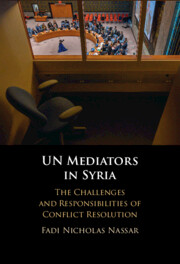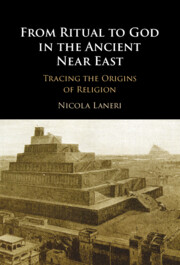276 results
Chapter 13 - The Antioch Mosaics
- from Part II - The Making of a Capital
-
-
- Book:
- Antioch on the Orontes
- Print publication:
- 06 June 2024, pp 207-224
-
- Chapter
- Export citation
14 - Yom Kippur
- from Part III - Decline
-
- Book:
- To Run the World
- Published online:
- 30 May 2024
- Print publication:
- 30 May 2024, pp 392-426
-
- Chapter
- Export citation
3 - The Quiet Negotiator
-
- Book:
- UN Mediators in Syria
- Published online:
- 16 May 2024
- Print publication:
- 23 May 2024, pp 91-150
-
- Chapter
- Export citation
5 - Conclusion
-
- Book:
- UN Mediators in Syria
- Published online:
- 16 May 2024
- Print publication:
- 23 May 2024, pp 233-264
-
- Chapter
- Export citation
1 - Introduction
-
- Book:
- UN Mediators in Syria
- Published online:
- 16 May 2024
- Print publication:
- 23 May 2024, pp 1-34
-
- Chapter
- Export citation
2 - The Global Statesman
-
- Book:
- UN Mediators in Syria
- Published online:
- 16 May 2024
- Print publication:
- 23 May 2024, pp 35-90
-
- Chapter
- Export citation

UN Mediators in Syria
- The Challenges and Responsibilities of Conflict Resolution
-
- Published online:
- 16 May 2024
- Print publication:
- 23 May 2024

From Ritual to God in the Ancient Near East
- Tracing the Origins of Religion
-
- Published online:
- 03 May 2024
- Print publication:
- 09 May 2024
Demographics and risk factors for suicide in Syria: A retrospective media content analysis of online news sources
-
- Journal:
- Cambridge Prisms: Global Mental Health / Volume 11 / 2024
- Published online by Cambridge University Press:
- 12 April 2024, e50
-
- Article
-
- You have access
- Open access
- HTML
- Export citation
2 - Pharaonic Egypt
-
- Book:
- Slavery and Dependence in Ancient Egypt
- Published online:
- 01 March 2024
- Print publication:
- 21 March 2024, pp 37-118
-
- Chapter
- Export citation
Chapter 5 - Lord of the Universe, the World and Eternity
-
-
- Book:
- The Names of the Gods in Ancient Mediterranean Religions
- Published online:
- 23 February 2024
- Print publication:
- 07 March 2024, pp 95-110
-
- Chapter
- Export citation
Bridging the first-aid knowledge gap: a cross-sectional study of medical scope students in Syria
-
- Journal:
- Primary Health Care Research & Development / Volume 25 / 2024
- Published online by Cambridge University Press:
- 08 February 2024, e8
-
- Article
-
- You have access
- Open access
- HTML
- Export citation
9 - Refugees’ Vulnerability towards Precarious Work
-
-
- Book:
- Diversity and Precarious Work During Socio-Economic Upheaval
- Published online:
- 01 February 2024
- Print publication:
- 08 February 2024, pp 163-182
-
- Chapter
- Export citation
The first validated record of Epinephelus areolatus (Forsskål, 1775) (Perciformes: Serranidae) from Syrian marine waters
-
- Journal:
- Journal of the Marine Biological Association of the United Kingdom / Volume 103 / 2023
- Published online by Cambridge University Press:
- 28 November 2023, e93
-
- Article
- Export citation
2 - Interstate Uses of Force, Tensions and Restraints by Regions since World War II
-
- Book:
- A Farewell to Wars
- Published online:
- 09 November 2023
- Print publication:
- 23 November 2023, pp 15-32
-
- Chapter
- Export citation
International memories in global politics: Making the case for or against UN intervention in Libya and Syria
-
- Journal:
- Review of International Studies / Volume 50 / Issue 2 / March 2024
- Published online by Cambridge University Press:
- 13 November 2023, pp. 271-288
- Print publication:
- March 2024
-
- Article
-
- You have access
- Open access
- HTML
- Export citation
10 - The Doctrine of Humanitarian Intervention
- from Part IV - Forcible Intervention in Situations of Civil Unrest
-
- Book:
- The Use of Force and International Law
- Published online:
- 26 October 2023
- Print publication:
- 09 November 2023, pp 486-522
-
- Chapter
- Export citation
4 - Secularist Leaders in the Levant
-
- Book:
- Leaders in the Middle East and North Africa
- Published online:
- 03 August 2023
- Print publication:
- 17 August 2023, pp 76-101
-
- Chapter
- Export citation
21 - The Mongols and the Arab Middle East
- from Volume I Part 4 - External Histories
-
-
- Book:
- The Cambridge History of the Mongol Empire
- Published online:
- 01 January 2024
- Print publication:
- 17 August 2023, pp 798-826
-
- Chapter
- Export citation
10 - The Ukrainian and Syrian Conflicts: Civil Wars or Geopolitical Shatterbelts?
-
-
- Book:
- Rethinking Warfare in the 21st Century
- Published online:
- 29 June 2023
- Print publication:
- 13 July 2023, pp 273-307
-
- Chapter
- Export citation



